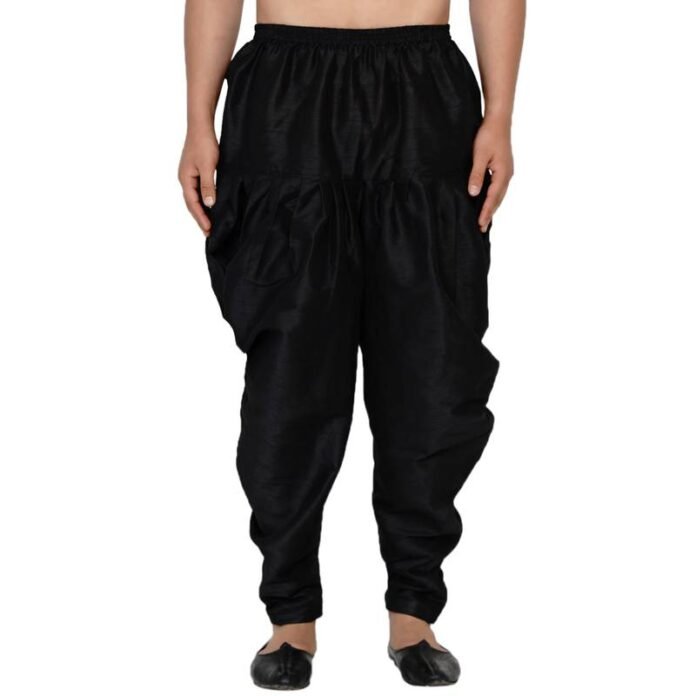Last Updated on July 14, 2024 by Asfa Rasheed
In Indian culture, the simple unstitched dhoti carries deeper meaning beyond its modest day-to-day functionality. Through stories and rituals, the plain dhoti transforms into symbolic fabrics of honor and community steering social order for generations.
By exploring the nuances embedded in dhotis, we better understand foundations upholding India’s intricate social framework valuing humility as aspirational virtue.
Table of Contents
Defining the Practical Dhoti
A dhoti is made of 4 to 6 yards cotton or silk sheathed around the lower half of the body. Typically worn by men in rural settings or for religious purposes, soft whites and lightweight fabrics keep cool while leg wraps enable laboring mobility from fields to temples.
The functional garment also lends efficient wash-and-wear maintenance ideal for common castes and conditions focused on service needs rather than social status like higher purpose khadi.
Legend Behind the Virtuous Dhoti
According to Hindu mythology, in a legendary feud the mighty elephant god Ganesha fought his brother Murugan over who was superior. Trying to end matters, wise father Lord Shiva pronounced Murugan the winner.
But Ganesha accepted defeat humbly without outrage. So moved was Lord Shiva by Ganesha’s restraint, he granted the elephant god superiority and perpetual worship.
It’s said Ganesha’s humility tied the fabled dhoti ever loosely so ego could not thus tighten it swelling pride. This virtue established the unstitched garb tied imperfectly yet cleanly as honorable uniform. Thereafter in Indian culture, dhotis distinguished men walking spiritual grounds in principled grace.
Regional Style Variations
While techniques differ wearing dhotis across rural regions, wrappings retain virtue signalling inner qualities over outer appearances.
In hot humid Tamil Nadu, the veshti dhoti loses excess folds focusing functional minimalism showing discipline and integrity.
In Bengal, intricate kachcha contrasts refine white dhotis as status markers. But wearing standards without airs when seating signifies equality in gatherings regardless of social strata.
In Assam and Orissa, dhotis bear iconic patterns as identity instilling cultural dignity within communities through a shared everyday medium.
Ceremonial Dhoti Rituals
Donning dhotis carries sentimental gravity during landmark ceremonies directing key life stages.
The men’s dhoti and uttariyam shoulder veil ritually cover Tamil grooms with marriage protection and responsibility mixed in folds.
In Marathi weddings, guests bless yellow dhoti gift exchanges calling prosperity into matrimony like sun rays light day.
At Hindu funerals, male elders solemnly wear plain white dhotis expressing purity sentiments in mourning loss of life extinguished yet remembered.
Through so many rites of passage journeys, the unassuming dhoti quietly centers values grounding chaos in clothed purpose and focus.
The Gandhian Khadi: Spinning Swaraj Spirit
But beyond mythology and matrimony, the dhoti wove into India’s independence fight as disciplined political uniform under Gandhi transforming slave clothing into soul force.
Gandhi envisioned the empowering khadi dhoti – handspun on charkas and self-woven – as manifesto mobilizing villages toward freedom in economic autonomy and national solidarity.
Khadi dhotis with towels consequently draped Congress supporting satyagrahis abstaining British taxation on Indian mill cloth that suppressed growth of the localized cottage weaving industry and rural guilds.
This swadeshi economic disobedience banded towards a self-sufficient model strengthening decentralized society. Handmade khadi thus carried deeper nationalism meaning self-reliance vital for ethical democracy and cultural continuity.
Even after British departures, politicians active in public service don khadis paying respect to economic and social freedom fought for wearing the meaningful threads of India’s independence struggle message at heart.
Conclusion: Carrying Values in Folds
Beyond body covering utility, a diverse heritage intricately binds and steadies Indian society’s moral character upon humble dhoti foundations holding lives, memories and mass movements through storied stitches across sacred geography. Carefully draped or loosely tied, the unassuming dhoti carries values ensuring cultural integrity and continuity weave through history.





















